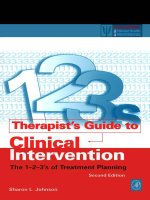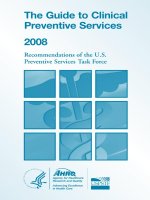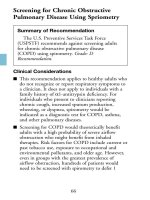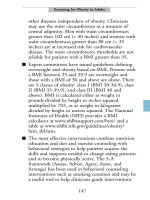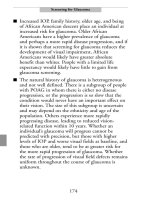The Guide to Clinical Preventive Services 2008 - part 9 pot
Bạn đang xem bản rút gọn của tài liệu. Xem và tải ngay bản đầy đủ của tài liệu tại đây (152.65 KB, 27 trang )
Clinical Considerations
■ The most common causes of visual impairment in
children are: (1) amblyopia and its risk factors and
(2) refractive error not associated with amblyopia.
Amblyopia refers to reduced visual acuity without a
detectable organic lesion of the eye and is usually
associated with amblyogenic risk factors that
interfere with normal binocular vision, such as
strabismus (ocular misalignment), anisometropia (a
large difference in refractive power between the 2
eyes), cataract (lens opacity), and ptosis (eyelid
drooping). Refractive error not associated with
amblyopia principally includes myopia
(nearsightedness) and hyperopia (farsightedness);
both remain correctable regardless of the age at
detection.
■ Various tests are used widely in the United States to
identify visual defects in children, and the choice of
tests is influenced by the child’s age. During the
first year of life, strabismus can be assessed by the
cover test and the Hirschberg light reflex test.
Screening for Visual Impairment in
Children Younger Than Age 5 Years
201
Summary of Recommendation
The U.S. Preventive Services Task Force
(USPSTF) recommends scr
eening to detect
amblyopia, strabismus, and defects in visual acuity
in children younger than age 5 years. Grade: B
Recommendation.
Screening children younger than age 3 years for
visual acuity is more challenging than screening
older children and typically requires testing by
specially trained personnel. Newer automated
techniques can be used to test these children.
Photoscreening can detect amblyogenic risk factors
such as strabismus, significant refractive error, and
media opacities; however, photoscreening cannot
detect amblyopia.
■ Traditional vision testing requires a cooperative,
verbal child and cannot be performed reliably until
ages 3 to 4 years. In children older than age 3 years,
stereopsis (the ability of both eyes to function
together) can be assessed with the Random Dot E
test or Titmus Fly Stereotest; visual acuity can be
assessed by tests such as the HOTV chart, Lea
symbols, or the tumbling E. Some of these tests
have better test characteristics than others.
■ Based on their review of current evidence, the
USPSTF was unable to determine the optimal
screening tests, periodicity of screening, or technical
proficiency required of the screening clinician.
Based on expert opinion, the American Academy of
Pediatrics (AAP) recommends the following vision
screening be performed at all well-child visits for
children starting in the newborn period to 3 years:
ocular history, vision assessment, external inspection
of the eyes and lids, ocular motility assessment,
pupil examination, and red reflex examination. For
children aged 3 to 5 years, the AAP recommends
the aforementioned screening in addition to age-
202
Visual Impairment in Children Younger Than Age 5 Years
appropriate visual acuity measurement (using
HOTV or tumbling E tests) and ophthalmoscopy.
1
■ The USPSTF found that early detection and
treatment of amblyopia and amblyogenic risk
factors can improve visual acuity. These treatments
include surgery for strabismus and cataracts; use of
glasses, contact lenses, or refractive surgery
treatments to correct refractive error; and visual
training, patching, or atropine therapy of the
nonamblyopic eye to treat amblyopia.
■ These recommendations do not address screening
for other anatomic or pathologic entities, such as
macro cornea, cataracts, retinal abnormalities, or
neonatal neuroblastoma, nor do they address newer
screening technologies currently under
investigation.
Reference
1. American Academy of Pediatrics Committee on Practice
and Ambulatory Medicine and Section on
Ophthalmology, American Association of Certified
Orthoptists, American Association of Pediatric
Ophthalmology and Strabismus, American Academy of
Ophthalmology. Eye examination in infants, children,
and young adults by pediatricians: policy statement.
Pediatrics. 2003;111(4):902-907.
This USPSTF recommendation was first published in:
Ann Fam Med. 2004;2:263-266.
203
Visual Impairment in Children Younger Than Age 5 Years
and Index
206
Appendix A
Appendix A
Grade Definition Suggestions for Practice
A The USPSTF recommends the service. There is Offer or provide this service.
high certainty that the net benefit is substantial.
How the U.S. Preventive Services Task Force Grades Its Recommendations
The U.S. Preventive Services Task Force (USPSTF) assigns one of five letter grades to each of its
recommendations (A, B, C, D, or I). The USPSTF changed its grade definitions based on a change in
methods in May 2007.
Grade Definitions After May 2007
What the Grades Mean and Suggestions for Practice
The USPSTF updated its definitions of the grades it assigns to recommendations and now includes
“suggestions for practice” associated with each grade. The USPSTF has also defined levels of certainty
regarding net benefit. These definitions apply to USPSTF recommendations voted on after May 2007.
continued
Appendix A
207
Grade Definition Suggestions for Practice
B The USPSTF recommends the service. There is Offer or provide this service.
high certainty that the net benefit is moderate or
there is moderate certainty that the net benefit is
moderate to substantial.
C The USPSTF recommends against routinely Offer or provide this service only if
providing the service. There may be considerations other considerations support the
that support providing the service in an individual offering or providing the service
patient. There is at least moderate certainty that in an individual patient.
the net benefit is small.
D The USPSTF recommends against the service. Discourage the use of this service.
There is moderate or high certainty that the service
has no net benefit or that the harms outweigh the
benefits.
I Read the clinical considerations section
Statement The USPSTF concludes that the current evidence of USPSTF Recommendation
is insufficient to assess the balance of benefits and Statement. If the service is offered,
harms of the service. Evidence is lacking, of poor patients should understand the
quality, or conflicting, and the balance of benefits uncertainty about the balance of benefits
and harms cannot be determined. and harms.
208
Appendix A
Levels of Certainty Regarding Net Benefit
Level of Certainty* Description
High The available evidence usually includes consistent results from well-designed, well-
conducted studies in representative primary care populations. These studies assess
the effects of the preventive service on health outcomes. This conclusion is therefore
unlikely to be strongly affected by the results of future studies.
Moderate The available evidence is sufficient to determine the effects of the preventive service
on health outcomes, but confidence in the estimate is constrained by such factors as:
• The number, size, or quality of individual studies.
• Inconsistency of findings across individual studies.
• Limited generalizability of findings to routine primary care practice.
• Lack of coherence in the chain of evidence.
As more information becomes available, the magnitude or direction of the observed
effect could change, and this change may be large enough to alter the conclusion.
continued
209
Appendix A
Level of Certainty* Description
Low The available evidence is insufficient to assess effects on health outcomes. Evidence
is insufficient because of:
• The limited number or size of studies.
• Important flaws in study design or methods.
• Inconsistency of findings across individual studies.
• Gaps in the chain of evidence.
• Findings not generalizable to routine primary care practice.
• Lack of information on important health outcomes.
More information may allow estimation of effects on health outcomes.
* The USPSTF defines certainty as “likelihood that the USPSTF assessment of the net benefit of a preventive
service is correct.” The net benefit is defined as benefit minus harm of the preventive service as implemented in
a general, primary care population. The USPSTF assigns a certainty level based on the nature of the overall
evidence available to assess the net benefit of a preventive service.
210
Appendix A
Grade Definitions Prior to May 2007
The definitions below (of USPSTF grades and quality of
evidence ratings) were in use prior to the update in methods
and apply to recommendations voted on by the USPSTF
prior to May 2007.
A Strongly Recommended: The USPSTF strongly
recommends that clinicians provide [the service] to
eligible patients. The USPSTF found good evidence that
[the service] improves important health outcomes and
concludes that benefits substantially outweigh harms.
B Recommended: The USPSTF recommends that
clinicians pro
vide [the service] to eligible patients. The
USPSTF found at least fair evidence that [the service]
improves important health outcomes and concludes that
benefits outweigh harms.
C No Recommendation: The USPSTF makes no
recommendation for or against routine provision of [the
service]. The USPSTF found at least fair evidence that [the
service] can improve health outcomes but concludes that the
balance of benefits and harms is too close to justify a general
recommendation.
D Not Recommended: The USPSTF recommends against
routinely providing [the service] to asymptomatic
patients. The USPSTF found at least fair evidence that
[the service] is ineffective or that harms outweigh benefits.
I Insufficient Evidence to Make a Recommendation:
The USPSTF concludes that the evidence is insufficient
to recommend for or against routinely providing [the
service]. Evidence that [the service] is effective is lacking, of
poor quality, or conflicting and the balance of benefits and
harms cannot be determined.
211
Appendix A
Quality of Evidence
The USPSTF grades the quality of the overall evidence
for a service on a 3-point scale (good, fair, poor):
Good: Evidence includes consistent results from well-
designed, well-conducted studies in representative
populations that directly assess effects on health
outcomes.
Fair: Evidence is sufficient to determine effects on health
outcomes, but the strength of the evidence is limited
by the number
, quality, or consistency of the
individual studies, generalizability to routine
practice, or indirect nature of the evidence on health
outcomes.
Poor: Evidence is insufficient to assess the effects on health
outcomes because of limited number or power of
studies, important flaws in their design or conduct,
gaps in the chain of evidence, or lack of information
on important health outcomes.
212
Appendix B
Members of the U.S. Preventive Services
Task Force 2001-2007
Janet D. Allan, Ph.D.,
R.N., C.S., F.A.A.N.
School of Nursing
University of Maryland,
Baltimore
Baltimore, MD
Alfred O. Berg, M.D.,
M.P.H.
Department of Family
Medicine
University of Washington
Seattle, WA
Ned Calonge, M.D., M.P.H.
Colorado Department of
Public Health and
Environment
Denver, CO
Thomas G. DeWitt, M.D.
Department of Pediatrics,
Children’s Hospital
Medical Center
Cincinnati, OH
Allen J. Dietrich, M.D.
Dartmouth Medical School
Hanover, NH
Paul S. Frame, M.D.
Tri-County Family Medicine
Cohocton, NY
Joxel Garcia, M.D., M.B.A.
Pan American Health
Organization
Washington, DC
Leon Gordis, M.D., Dr. P.H.
Epidemiology Department
Johns Hopkins Bloomberg
School of Public Health
Baltimore, MD
Kimberly D. Gregory,
M.D., M.P.H.
Department of Obstetrics
and Gynecology
Cedars-Sinai Medical Center
Los Angeles, CA
David Grossman, M.D.,
M.P.H.
Center for
Health Studies, Group
Health Cooperative
University of Washington
Seattle, WA
Russell Harris, M.D.,
M.P.H.
University of North
Carolina School of
Medicine
Chapel Hill, NC
Appendix B
213
Charles J. Homer, M.D.,
M.P.H.
National Initiative for
Children’s Healthcare
Quality
Boston, MA
George Isham, M.D., M.S.
HealthPartners
Minneapolis, MN
M
ark S. Johnson, M.D.,
M.P.H.
Department of Family
Medicine
New Jersey Medical School
University of Medicine and
Dentistry of New Jersey
Newark, NJ
Kenneth Kizer, M.D.,
M.P.H.
National Quality Forum
Washington, DC
Jonathan D. Klein, M.D.,
M.P.H.
Department of Pediatrics
University of Rochester
Rochester, NY
Tracy A. Lieu, M.D.,
M.P.H.
Department of Ambulatory
Care and Prevention
Harvard Pilgrim Health
Care and Harvard Medical
School
Boston, MA
Michael L. LeFevre, M.D.,
M.S.P.H.
U
niversity of Missouri
School of Medicine
Columbia, MO
Rosanne Leipzig, M.D.,
Ph.D.
G
eriatrics and Adult
Development Medicine,
Health Policy
Mount Sinai School of
Medicine
New York, NY
Carol Loveland-Cherry,
P
h.D., R.N., F.A.A.N.
Office of Academic Affairs
School of Nursing
University of Michigan
Ann Arbor, MI
Lucy N. Marion, Ph.D.,
R.N.
School of Nursing, Medical
College of Georgia
Augusta, GA
Bernadette Melnyk, Ph.D.,
R.N., C.P. N.P
./N.P.P.
College of Nursing &
Healthcare Innovation
Arizona State University
Phoenix, AZ
Virginia A. Moyer, M.D.,
M.P.H.
Department of Pediatrics
University of Texas Health
Science Center
Houston, TX
Cynthia D. Mulrow, M.D.,
M.Sc.
University of Texas Health
Science Center
Audie L. M
urphy Memorial
Veterans Hospital
San Antonio, TX
Judith K. Ockene, Ph.D.,
M.Ed.
Division of Preventive and
Behavioral Medicine
University of Massachusetts
Medical School
Worcester, MA
C. Tracy Orleans, Ph.D.
Department of Research and
Evaluation
The Robert Wood Johnson
Foundation
Princeton, NJ
Jeffrey F. Peipert, M.D.,
M.P.H.
Women and Infants’
Hospital
Providence, RI
Nola J. Pender, Ph.D., R.N.
School of Nursing
Univ
ersity of Michigan
Ann Arbor, MI
Diana B. Petitti, M.D.,
M.P.H.
U
niversity of Southern
California
Los Angeles, CA
George F. Sawaya, M.D.
Department of Obstetrics,
G
ynecology, and
Reproductive Sciences
Department of
Epidemiology and
Biostatistics
University of California,
San Francisco
San Francisco, CA
J. Sanford (Sandy)
Schwartz, M.D.
University of Pennsylvania
School of Medicine and
Wharton School
Philadelphia, PA
Harold C. Sox, Jr., M.D.
Department of Medicine
Dartmouth-Hitchcock
Medical Center
Lebanon, NH
214
Appendix B
215
Appendix B
Albert L. Siu, M.D.,
M.S.P.H.
Brookdale Department of
Geriatrics and Adult
Development
Mount Sinai Medical Center
New York, NY
Steven M. Teutsch, M.D.,
M.P.H.
M
erck and Company, Inc.
West Point, PA
Carolyn Westhoff, M.D.,
M.Sc.
Department of Obstetrics
and Gynecology
Columbia University
New York, NY
Timothy Wilt, M.D.,
M.P.H.
Department of Medicine,
Minneapolis VA Medical
Center
University of Minnesota
Minneapolis, MN
Steven H. Woolf, M.D.,
M.P.H.
D
epartment of Family
Practice, Preventive
Medicine, and
Community Health
Virginia Commonwealth
University
Fairfax, VA
Barbara P. Yawn, M.D.,
M.S.P.H., M.Sc.
O
lmstead Medical Center
Department of Research
Rochester, MN
216
Appendix C
Acknowledgments
AHRQ Staff Supporting the USPSTF
2001-2008
David Atkins, M.D., M.P.H.
Mary Barton, M.D., M.P.P.
Dana Best, M.D., M.P.H.
Joel Boches
Helen Burstin, M.D., M.P.H.
Mackenzie Cross
Sandra K. Cummings
Elizabeth Edgerton, M.D., M.P.H.
Farah Englert
Kenneth Fink, M.D., M.G.A., M.P.H.
Janice L. Genevro, Ph.D., M.S.W.
Barbara Gordon
Margi Grady
Janelle Guirguis-Blake, M.D.
Patrik Johansson, M.D.
Heather Johnson
Douglas Kamerow, M.D., M.P.H.
Hazel Keimowitz, M.A.
Kristie Kiser
Claire Kendrick, M.S.Ed.
David Lanier, M.D.
Morgan Liscinsky
Kenneth Lin, M.D.
Iris Mabry, M.D., M.P.H.
Corey Mackison, M.S.A.
David Meyers, M.D.
Tess Miller, Dr.P.H.
Kevin Murray
Barbara Najar, M.P.H.
Bridget O’Connell
Nilam Patel, M.P.H.
Amy Pfeiffer
Gurvaneet Randhawa, M.D., M.P.H.
Stacia Sanvick
Eve Shapiro
Randie Siegel, M.S.
Jean Slutsky, P.A., M.S.P.H.
Bill Sowers
Marion Torchia
Tricia Trinité, M.S.P.H., A.P.R.N.
Gloria Washington
Tracy Wolff, M.D., M.P.H.
Evidence-Based Practice Centers
Supporting the USPSTF 2001-2008
The following researchers working through three AHRQ
Evidence-Based Practice Centers prepared systematic
evidence reviews and evidence summaries as resources on
topics under consideration by the USPSTF.
Oregon Evidence-Based Practice Center
Mikel Aickin, Ph.D.; Sarah Baird, M.S.; Vance Bauer, M.A.;
Tracy Beil, M.S.; Christina Bougatsos, B.S.; Jessica Burnett;
David Buckley, M.D.; Taryn Cardenas, B.S.; Susan Carson,
M.P.H.; Benjamin K.S. Chan, M.S.; Roger Chou, M.D.;
Elizabeth Clark, M.D., M.P.H; Tracy Dana, M.L.S.; Robert
Davis, M.D., M.P.H.; Stephanie Detlefsen, M.D.; Karen B.
Eden, Ph.D.; Michelle Eder, Ph.D.; Craig Fleming, M.D.;
Michele Freeman, M.P.H.; Rochele Fu, Ph.D.; Betsy Garlitz,
M.D.; Nancy Glass, Ph.D., M.P.H., R.N.; Rachel Gold,
Ph.D., M.P.H; Carla A. Green, Ph.D., M.P.H.; Jeanne-
Marie Guise, M.D., M.P.H.; Andrew Hamilton, M.S.,
M.L.S.; Elizabeth Haney, M.D; Emily Harris, Ph.D.,
M.P.H.; Mark Helfand, M.D., M.P.H.; Theresa Hillier,
M.D., M.S.; Laurie Huffman, M.S.; Linda Humphrey,
M.D., M.P.H.; Devan Kansagara, M.D.; P. Todd Korthuis,
M.D., M.P.H; Kathryn Pyle Krages, M.A.; Erin Leblanc,
M.D., M.P.H.; Beth Liles, M.D.; Jennifer Lin, M.D.; Susan
217
Appendix C
Mahon, M.P.H.; Yasmin McInerney, M.D.; Heather
McPhillips, M.D., M.P.H.; Yvonne Michael, Sc.D.; Jill
Miller, M.D.; Cynthia D. Morris, Ph.D., M.P.H.; Arpana
Naik, M.D.; Heidi D. Nelson, M.D., M.P.H.; Rebecca
Newton-Thompson, M.D., M.Sc.; Susan Norris, M.D.,
M.P.H.; Peggy Nygren, M.S.; Michelle Pappas, B.A.; Rita
Panosca, M.D.; Kathy Pedula, M.S.; Daphne Plaut, M.L.S.;
Michael R. Polen, Ph.D.; Elizabeth O’Connor, Ph.D.; Gary
Rischitelli, M.D., J.D., M.P.H.; Cheryl Ritenbaugh, Ph.D.,
M.P.H.; Kevin Rogers, M.D.; Somnath Saha, M.D.,
M.P.H.; Scott A. Shipman, M.D., M.P.H.; Paula R. Smith,
R.N., B.S.N.; Ariel K. Smits, M.D., M.P.H.; Robert Steiner,
M.D.; Kelly Streit, M.S., R.D.; Lina M.A. Takano, M.D.,
M.S.; Diane Thompson, M.S.; Kari Tyne, M.D.; Kimberly
Vesco, M.D., M.P.H.; Kim Villemyer, B.A.; Miranda
Walker, B.A.; Carolyn Westhoff, M.D., M.Sc.; Evelyn P.
Whitlock, M.D., M.P.H.; Selvi B.Williams, M.D., M.P.H.;
Jennifer Wisdom, Ph.D., M.P.H.; Sarah Zuber, M.S.W.
RTI International/University of North Carolina
Evidence-
Based Practice Center
Alice Ammerman, Dr.P.H., R.D.; James D. Bader, D.D.S.,
M.P.H.; Rainer Beck, M.D.; John F. Boggess, M.D.; Malaz
Boustani, M.D., M.P.H.; Seth Brody, M.D.; Audrina J.
Bunton; Katrina Donahue, M.D., M.P.H.; Louise
Fernandez, PA-C, R.D., M.P.H.; Kenneth Fink, M.D.,
M.G.A., M.P.H.; Carol Ford, M.D.; Angela Fowler-Brown,
M.D.; Bradley N. Gaynes, M.D., M.P.H.; Paul Godley,
M.D., M.P.H.; Susan A. Hall, M.S.; Laura Hanson, M.D.,
M.P.H.; Russell Harris, M.D., M.P.H.; Katherine
E.Hartmann, M.D., Ph.D.; Michael Hayden, M.D.; M.
Brian Hemphill, M.D.; Alissa Driscoll Jacobs, M.S., R.D.;
Jana Johnson; Linda Kinsinger, M.D., M.P.H.; Carol
Krasnov; Ramesh Krishnaraj; Carole M. Lannon, M.D.,
M.P.H.; Carmen Lewis, M.D., M.P.H.; Kathleen N. Lohr,
Ph.D.; Linda J. Lux, M.P.A.; Kathleen McTigue, M.D.,
218
Appendix C
M.P.H.; Catherine Mills, M.A.; Kavita Nanda, M.D.,
M.H.S.; Carla Nester, M.D.; Britt Peterson, M.D., M.P.H.;
Christopher J. Phillips, M.D., M.P.H.; Michael Pignone,
M.D., M.P.H.; Mark Pletcher, M.D., M.P.H.; Saif S.
Rathore; Melissa Rich, M.D.; Gary Rozier, D.D.S.; Jerry L.
Rushton, M.D., M.P.H.; Lucy A. Savitz; Joe Scattoloni;
Stacey Sheridan, M.D., M.P.H.; Sonya Sutton, B.S.P.H.;
Jeffrey A. Tice, M.D.; Suzanne L. West, Ph.D.; B. Lynn
Whitener, Dr.P.H., M.S.L.S.; Margaret Wooddell, M.A.;
Dennis Zolnoun, M.D.
University of Ottawa Evidence-Based Practice Center
Nicholas Barrowman, Ph.D.; Catherine Code, M.D.,
F.R.C.P.C.; Catherine Dubé, M.D., M.Sc., F.R.C.P.C.;
Gabriela Lewin, M.D.; David Moher, Ph.D.; Alaa Rostom,
M.D., M.Sc., F.R.C.P.C.; Margaret Sampson, M.I.L.S.;
Alexander Tsertsvadze, M.D., M.Sc.
Liaisons to the USPSTF
Professional Organizations
American Academy of Family Physicians
American Academy of Nurse Practitioners
American Academy of Pediatrics
American Academy of Physician Assistants
American College of Obstetricians and Gynecologists
American College of Physicians
American College of Preventive Medicine
American Medical Association
American Osteopathic Association
America’s Health Insurance Plans
National Committee for Quality Assurance
National Organization of Nurse Practitioner Faculties
219
Appendix C
Government Agencies
Canadian Task Force on Preventive Health Care
Centers for Disease Control and Prevention
Centers for Medicare & Medicaid Services
Health Resources and Services Administration
Indian Health Services
Military Health System
National Institutes of Health
Office of Disease Prevention and Health Promotion
U.S. Food and Drug Administration
VA National Center for Health Promotion and Disease
Prevention
220
Appendix C
Appendix D
Advisory Committee on Immunization
Practices Recommended Immunization
Schedules
Recommended Immunization Schedule for
Persons Aged 0-6 Years 222
Recommended Immunization Schedule for
Persons Aged 7-18 Years 228
Catch-up Immunization Schedule for Persons Aged
4 Months-18 Years Who Start Late or Are More
Than 1 Month Behind 234
Recommended Adult Immunization Schedule 240
Figure 1. Recommended adult immunization
schedule, by vaccine and age group 240
Figure 2. Vaccines that might be indicated for
adults based on medical and other indications 242
221
The USPSTF recognizes the importance of
immunizations in primary disease prevention. The Task
Force refers to recommendations made by the Centers for
Disease Control and Prevention’s Advisory Committee on
Immunization Practices (ACIP) for immunization of
children and adults. The methods used by ACIP to review
evidence on immunizations may differ from the methods
used by the USPSTF.
222
Footnotes begin on page 224.
223
Appendix D
This schedule indicates the recommended ages for routine administration of currently licensed childhood
vaccines, as of December 1, 2007, for children aged 0 through 6 years. Additional information is available at
www.cdc.gov/vaccines/recs/schedules. Any dose not administered at the recommended age should be
administered at any subsequent visit, when indicated and feasible. Additional vaccines may be licensed and
recommended during the year. Licensed combination vaccines may be used whenever any components of the
combination are indicated and other components of the vaccine are not contraindicated and if approved by the
Food and Drug Administration for that dose of the series. Providers should consult the respective Advisory
Committee on Immunization Practices statement for detailed recommendations, including for high-risk
conditions: Clinically significant adverse events that
follow immunization should be reported to the Vaccine Adverse Event Reporting System (VAERS). Guidance
about how to obtain and complete a VAERS form is available at www.vaers.hhs.gov or by telephone, 800-
822-7967.
Footnotes
1. Hepatitis B vaccine (HepB). (Minimum age: birth)
At birth:
• Administer monovalent HepB to all newborns prior to hospital discharge.
• If mother is hepatitis B surface antigen (HBsAg) positive, administer HepB and 0.5 mL of hepatitis B
immune globulin (HBIG) within 12 hours of birth.
• If mother’s HBsAg status is unknown, administer HepB within 12 hours
of birth. Determine the HBsAg status as soon as possible and if HBsAg positive, administer HBIG (no
later than age 1 week).
• If mother is HBsAg negative, the birth dose can be delayed, in rare cases, with a provider’s order and a
copy of the mother’s negative HBsAg laboratory report in the infant’s medical record.
After the birth dose:
• The HepB series should be completed with either monovalent HepB or a combination vaccine containing
HepB. The second dose should be administered at age 1-2 months. The final dose should be administered
no earlier than age 24 weeks. Infants born to HBsAg-positive mothers should be tested for HBsAg and
antibody to HBsAg after completion of at least 3 doses of a licensed HepB series, at age 9-18 months
(generally at the next well-child visit).
4-month dose:
• It is permissible to administer 4 doses of HepB when combination vaccines are administered after the
birth dose. If monovalent HepB is used for doses after the birth dose, a dose at age 4 months is not
needed.
224
Appendix D
2. Rotavirus vaccine (Rota). (Minimum age: 6 weeks)
• Administer the first dose at age 6-12 weeks.
• Do not start the series later than age 12 weeks.
• Administer the final dose in the series by age 32 weeks. Do not administer any dose later than age 32
weeks.
• Data on safety and efficacy outside of these age ranges are insufficient.
3. Diphtheria and tetanus toxoids and acellular pertussis vaccine (DTaP). (Minimum age: 6 weeks)
• The fourth dose of DTaP may be administered as early as age 12 months, provided 6 months have elapsed
since the third dose.
• Administer the final dose in the series at age 4-6 years.
4. Haemophilus influenzae type b conjugate vaccine (Hib). (Minimum age: 6 weeks)
• If PRP-OMP (PedvaxHIB
®
or ComVax
®
[Merck]) is administered at ages 2 and 4 months, a dose at age 6
months is not required.
• TriHIBit
®
(DTaP/Hib) combination products should not be used for primary immunization but can be
used as boosters following any Hib vaccine in children age 12 months or older.
5. Pneumococcal vaccine. (Minimum age: 6 weeks for pneumococcal conjugate vaccine [PCV]; 2 years for
pneumococcal polysaccharide vaccine [PPV])
• Administer one dose of PCV to all healthy children aged 24-59 months having any incomplete schedule.
• Administer PPV to children aged 2 years and older with underlying medical conditions.
6. Influenza vaccine. (Minimum age: 6 months for trivalent inactivated influenza vaccine [TIV]; 2 years for live,
attenuated influenza vaccine [LAIV])
225
Appendix D
